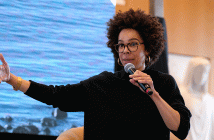Today, one would be hard pressed to find girls jumping Double Dutch on Bainbridge Avenue, or any other street in the city for that matter, said Roberts, who now spends five days a week on the Fordham campus as an executive secretary in the dean’s office at the Graduate School of Arts and Sciences, where she manages Dean Eva Badowska’s hectic calendar.
When not working, however, Roberts and several friends have set out to “keep the [Double Dutch] tradition alive” by meeting twice a month in Harlem just inside Central Park at Central Park North and Lenox Avenue for open practices. You can usually find the group at 2 p.m. on alternate Saturdays, inviting any and all interested parties to join in and learn the skill.
Roberts said that the all-female group members of Double Dutch Lovers NYC found each other through the website Meetup, organized by her friend Tina King. The women’s ages range from early 30s to early 50s, which speaks to the game’s heyday of the 1970s through the 1980s, Roberts said.
At that time in Bedford Park,—Fordham’s neighbor to the west—the middle-class home owners lived next to working-class renters, while neighbors with more trying circumstances lived just a few doors down. The one thing all the girls in the neighborhood had in common was jumping Double Dutch.
It was a period when the Bronx was going through a trying time, yet was also producing some of the nation’s most vibrant cultural movements. Roberts said that while Double Dutch’s popularity wasn’t an offshoot of hip-hop, it wasn’t exactly divorced from it either.
“Double Dutch is very rhythmic, and has a beat from when you’re landing your feet, and when the ropes hit the ground. Where there’s a turn and stomp, and a turn and stomp, you’re making music,” she said. “It’s not hip-hop, but the beat is the umbrella over it.”
The group has jumped with the Children’s Aid Society and the Boys and Girls Clubs of America, where the kids are “amazed at seeing someone jump two ropes.”
“They give it a shot and they usually do two, three, or four jumps,” she said.
Roberts said the group has brought her into contact with women she would have never known when she was a girl. Way over in Brooklyn, the girls had different names for “an inverted turning style” of jumping known there as “scotch,” but it was called “double orange” up in the Bronx.
“It’s a way to share this moment of when we were kids, when it was a just a way to be outside, have fun with other girls our age, to compete, and to push each other in a good way,” she said. “We used whatever we could—telephone extension cords, wires, clotheslines. You didn’t need a team or a uniform, just as long as you could jump.”


